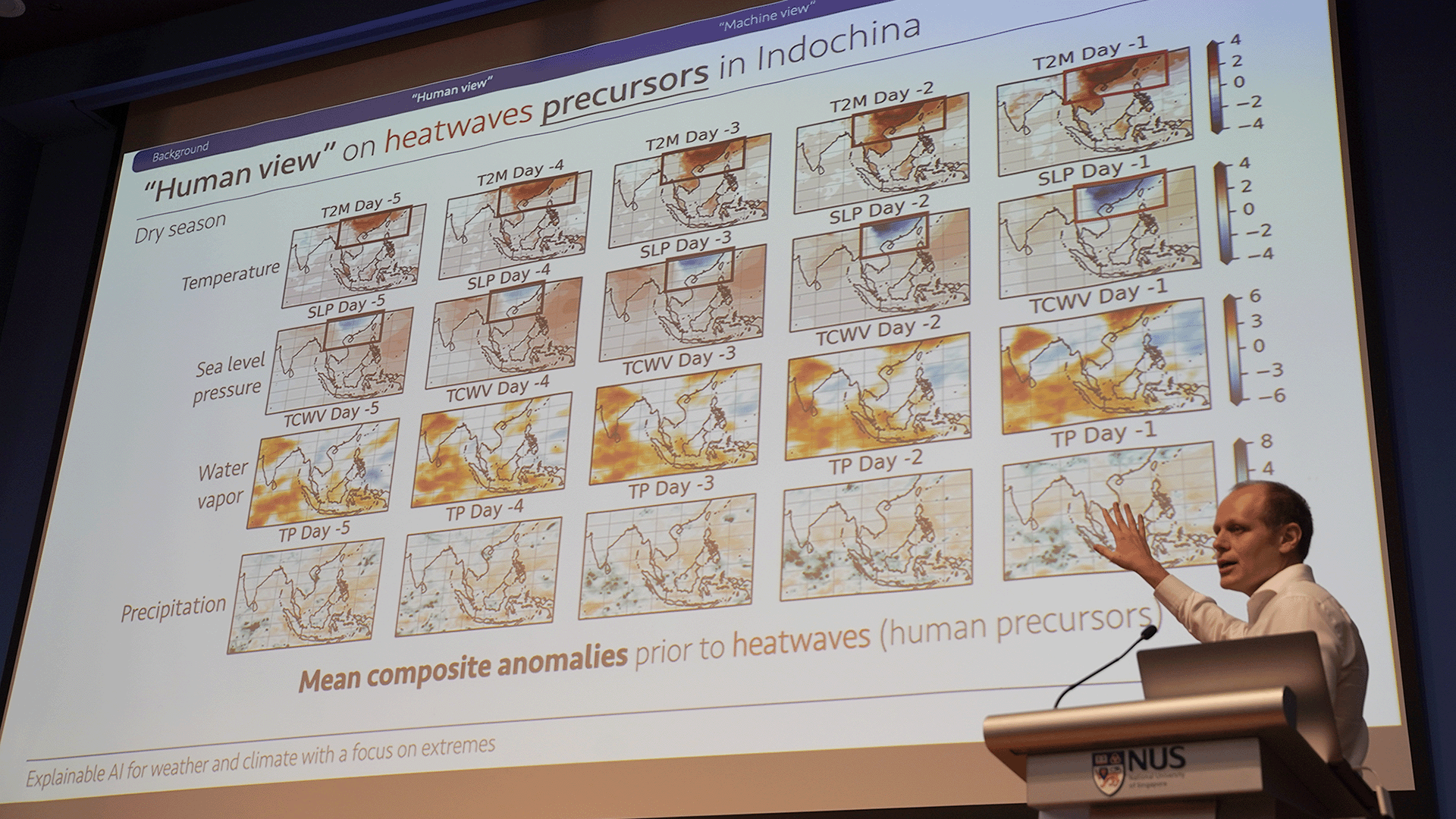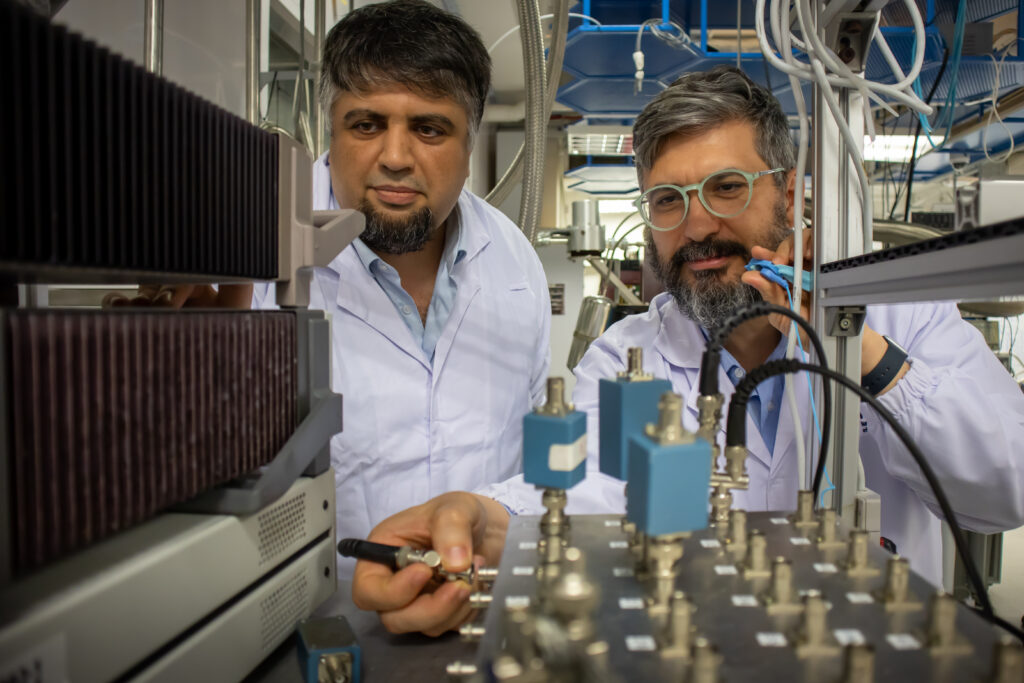HIGHLIGHTS
RESEARCH IMPACT & COLLABORATIONS
CDE hosts tech workshop in collaboration with NVIDIA


CDE, in collaboration with NVIDIA, recently brought together experts from industry and academia for a day-long workshop at NUS to explore the potential intersections between artificial intelligence, climate science, and quantum computing.
Held on January 26, 2024, the Al for Climate, Al for Science, and Quantum Workshop focused on the evolving landscapes of these transformative technologies and how AI might be applied to develop innovative solutions for some of the world's most pressing challenges.
In his welcome address for the event, CDE Acting Dean Prof Teo Kie Leong noted that recent swift advances in AI had generated “a new wave of opportunity for us to accelerate a positive impact on human civilisation.”
“NVIDIA, as a leading company developing high-performance tools for AI, serves as an enabling platform for many of our colleagues’ creative ideas and innovations,” Prof Teo said.
Read more at: https://cde.nus.edu.sg/news-detail/cde-hosts-tech-workshop-in-collaboration-with-nvidia/

Breakthrough boosts perovskite solar cell efficiency to new record
A breakthrough discovery in next-generation solar cell technology could help open the way to lighter, more flexible and more efficient solar panels.
The discovery by a team of researchers at CDE led by Assistant Professor Hou Yi (Presidential Young Professor, Chemical and Biomolecular Engineering and Solar Energy Research Institute of Singapore (SERIS)) involves the development of a new interface material that significantly improves the efficiency of perovskite solar cells.
Perovskites are a family of crystalline compounds with an unusual and complex structure. They are widely seen as the likely basis for future solar cells, replacing or being used in conjunction with silicon-based cells, due to factors such as greater flexibility, lighter weight, easier manufacturing processes, and – potentially – lower cost solar energy systems.
“Traditional silicon-based solar cells of the kind that we see on rooftops around the world, are a mature single-junction solar cell technology,” said Asst Prof Hou, who is head of the Perovskite-based Multijunction Solar Cell Group at SERIS, a university-level research institute hosted at CDE. “By stacking perovskite on top of silicon cells in a tandem cell configuration, the efficiency of the solar cell can be significantly enhanced.”
The team’s findings were published recently in the journal Nature Energy.
Read more at: https://cde.nus.edu.sg/news-detail/discovery-boosts-perovskite-solar-cell-efficiency-to-new-record/

Discovery unveils black phosphorus’s potential for innovative spintronics
Researchers at CDE have announced a significant discovery in the field of spintronics - a fast-growing approach to power efficiency that could revolutionise the development of low-power electronic devices.
The research collaboration between groups led by Assistant Professor Ahmet Avsar and Professor Barbaros Özyilmaz (both from Materials Science and Engineering) delves into the unique properties of an ultrathin, two-dimensional material called black phosphorus and how it transports spinning electrons.
The team’s findings were published recently in the journal Nature Materials.
Unlike traditional electronics, which rely on the movement of electrical charge, spintronics utilises the intrinsic spin of electrons to create more energy-efficient devices.
Electrons have a spin state of "up" or "down" causing the electrons to act like tiny magnets and manipulating this state has been seen by researchers as crucial for achieving lower power operation in electronic devices. This is because the spin motion of electrons inherently dissipates far less heat than the movement of electrical charge used in traditional electronics.
Whilst the phenomenon of spin itself has been widely studied, the challenge has been finding a material with the optimal properties for creating the channels that transport spins.
Read more at: https://cde.nus.edu.sg/news-detail/discovery-unveils-black-phosphoruss-potential-for-innovative-spintronics/
Major Grants Awarded
The major grants (start date in January 2024) with total project value > $1M.
| HOSTING UNIT | PROJECT TITLE | FUNDING PROGRAMME
(SOURCE OF FUNDING) |
PRINCIPAL INVESTIGATOR | CO-INVESTIGATOR |
| CEE | HARNESSING BIG DATA TO PLAN A CLIMATE-RESILIENT FOOD BOWL FOR SINGAPORE | CLIMATE IMPACT SCIENCE RESEARCH (CISR) PROGRAMME - 2023 (NRF) | HE XIAOGANG | YE ZHISHENG; GIN YEW-HOONG, KARINA; LUO WEI (GEOGRAPHY) |
| DOA | SENSING AND SHAPING AIR FLOW TO MITIGATE HEAT FOR IMPROVING CLIMATE RESILIENCE IN HIGH DENSITY COASTAL CITIES | MND RESEARCH & INNOVATION FUND BY URA – 2023 (URA) | YUAN CHAO | RUDI MARIA FRANS ANNE STOUFFS |
| MSE | HIGH-FREQUENCY EXPLORATION OF TWIST-CONTROLLED MOIRE STRUCTURES: FROM INTERACTION EFFECTS TO QUANTUM GEOMETRY | ACRF TIER 2 GRANT – 2023 (MOE) | DENIS BANDURIN | |
| ECE | STOCHASTIC SPIN DEVICES AND ITS APPLICATION TO TRAVELING SALESMAN PROBLEMS | ACRF TIER 2 GRANT – 2023 (MOE) | YANG HYUNSOO | FONG XUANYAO |
| CHBE | NAVIGATING CHARGE SEPARATION AT DESIGNER CONJUGATED POLYMER/PEROVSKITE NANOCRYSTAL INTERFACE | ACRF TIER 2 GRANT – 2023 (MOE) | LIN ZHIQUN | |
| BME | DRUG OCCUPANCY IN EXTRACELLULAR VESICLES: MULTIPLEXED PROFILING IN VESICLE SUBPOPULATIONS | ACRF TIER 2 GRANT – 2023 (MOE) | SHAO HUILIN | LIM YOULIANG BRIAN (COMPUTER SCIENCE) |
| BME | TRANSFORMATIVE NANOPLASMONICS FOR MOLECULAR PROFILING OF EXTRACELLULAR VESICLES | NRF OPEN/GENERAL COMPETITIVE RESEARCH PROGRAM (NRF-CRP) - 2022 (NRF) | SHAO HUILIN; LIM YOULIANG BRIAN (COMPUTER SCIENCE); TAM KIT CHUNG JOHN (SURGERY) | |
| MSE | TACLTM 1: TACTILE LARGE TEXTURE MODELS | NATIONAL ROBOTICS PROGRAMME (NRP) BUSINESS AS USUAL (BAU) FUNDING INITIATIVE (FI) – 2023 (A*STAR) | TEE CHEE KEONG |


